Today people buy their gasoline from convenience stores or at truck stops when traveling. When I was growing up, the only place in town to buy gas was at a full-service gas station, a.k.a. a “filling station.”
The gas station was also commonly called a “service station,” and for good reason. When you drove your car or truck into the drive of the service station and ran over a hose that triggered a bell inside, a cheerful attendant came out and asked “What’ll it be?” Not only did the gas jockey put gas in your tank, but he or she would also wipe your windshield, check the tire pressure, oil, antifreeze, inspect wiper blades, and in some cases, sweep or vacuum out your vehicle.
I would usually ask for a “dollar or two” of regular and “check the oil.” My old jalopies did not need the higher octane, and higher-priced, “Ethyl.” For you youngsters out there, Ethyl was a brand of anti-knock (octane booster) fuel additive that contained tetraethyl lead. In fact, all gasoline contained lead until the 1970s.

When I started driving in the mid-1960s, gas was around 25.9 cents a gallon. In 1966, I remember a gas war in Sapulpa, where the price plummeted to 15.9 cents a gallon. While those prices seem extraordinarily cheap, you must remember that the minimum wage was $1.25 per hour.
Oil companies and service station owners offered “freebies” to obtain your business. Stations gave away S&H Green Stamps, dinner glasses, and dish sets to entice prospective customers.
Owning a service station was quite profitable back in the day. Although there was not a big mark-up on gasoline, the sale of oil, wiper blades, batteries, tires, and other accessories augmented the meager margin on fuel. The gas station also gave away free road maps.
On top of the sale of those sundry items, most stations had one or two garage bays, with a lift, so they could change oil, do tune-ups, replace a muffler, replace brakes, and do other minor mechanical work.
There used to be a Skelly station at the Northeast corner of Taft Ave. and Mission St. (which is currently the J&A Castrol Lube Express ) that was owned by “Junior” Guinn, one of Dad’s customers.
Junior had a great sense of humor. One day my 1957 Pontiac was filling up with sweet-smelling steam. I pulled into Junior’s station and he quickly diagnosed the problem, a leaking heater core. He suggested I find one at the salvage and he would install it. He then bypassed the heater. It was around 20 degrees outside and when I asked how I could keep warm in the meantime, he replied, “Get ya a hot gal!” For the record, I froze until it was repaired.
More than not, you could find mechanics at these stations who could do more than minor repairs. In the 1970s, I took a 1965 Chevy El Camino to Charlie Drake’s Texaco station on Dewey Ave. because my manual transmission was acting up. I trusted Charlie because he had worked for Denver Grigsby’s Skelly station. He was competent, friendly, and prompt. For a paltry $66.50, he removed the transmission, had it rebuilt, and replaced it within 24 hours.
Service stations on the road were often life-savers when a mechanical emergency arose while on a trip. My dad was driving our 1967 Camaro to Liberty, Texas. Somewhere around Conroe, Texas, Dad jumped a fan belt, and the car quickly overheated. Fortunately, he spotted a gas station that had a sign that read “mechanic on duty.” He pulled in, and when the attendant opened the hood, the radiator cap blew off. A couple of hours later we were on our way.
Many young people my age loved pulling pranks on the gas jockeys. I had a friend who owned a Chevrolet Corvair, which by the way, had an air-cooled engine, and he would ask the person at the pump to “check the antifreeze.” One poor fellow came up to my buddy and asked, “Where the hell is your radiator?”
A friend of mine said that when she was a teenager growing up in Oklahoma City, she and her friends would drive up and down Classen Blvd., stopping at each gas station along the street, purchasing only 26 cents worth, then going on to the next station. Apparently, this was a major source of amusement. And of course, the girls checked out the male attendants and conversely, the male attendants would check out the girls.
The oil crisis of the seventies started the downfall of the full-service stations. Oil companies found that customers were willing to pump their own gas “To save a few pennies.”
The last full-service station in Sapulpa was Ed Stockard’s Gulf station on the southeast corner of Taft Ave. and Mission St. Like so many other small businesses that offered personalized service, the full-station gas station has, for the most part, become another relic of the past.










